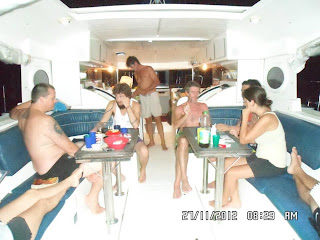Gronn and his mates had
found a boat and there were a couple of spaces left, so they were happy to have
us join them for the ride. We all met up again in Cartagena, and a couple of
days before we were due to leave we met Loic, one of the French captains, and
talked to him about the boat and all the details. A few of the guys also went
and checked out the boat - a 15m Atoll 6 called the Velero Amande, with 6 double cabins and 4 bathrooms - and gave it the all clear, so we were all set. We just
had to buy a few supplies in the form of about 4 cases of beer, 4 litres of
rum, 2 litres of aguardiente, 1.5 litres of vodka (all of this was just for the 2 of us of
course) and a few snacks, then we were good to go.
 |
The two Irish brothers in
the group, Martin and Shane, arrived in Cartagena the day before we sailed so Loic wasn't able to get our passports stamped at customs before we left. He
also hadn't been able to get the harbourmaster's permission for his boat to
leave, so we were going to have to try and sneak out at night and get our
passports stamped the next day at another place. We arrived at the port in
small groups about 20mins apart, so as not to arouse the suspicion of the
officials, and all made it safely onboard under the cover of night. We had a
celebratory drink then stealthily set off to leave the harbour. Most sailing
trips last about 5 days, but our captains, Loic and Frank, said they were
relaxed about how long it took us and we could do whatever we wanted. Off to a
great start then. The optimism soon started to wane though and nausea quickly
set in, with Steph being the first to succumb. It became fairly obvious that
not all of us had our sea legs. Not even close. That first night was pretty
rough for a few of us, and Kurt and I and Steph and Alex chose to sleep in the
sheltered sitting area as it had more fresh air than the cabins below deck. Loic and Frank were awesome, emptying our buckets and dishing out tissues and
water all night long. We must have been a sorry sight.
 |
| The crew |
 |
| Chess and cards are a serious business |
The next week was spent
sailing a bit each day or night, anchoring at beautiful spots to swim in the
crystal clear waters and snorkel over some amazing reefs, even a shipwreck off
one of the San Blas islands. Loic and Frank also outdid themselves with the
cooking, producing some awesome food for us, sometimes while sailing over
pretty rough waters. We even had some fresh barracuda ceviche and beautifully
cooked fillets, caught as we were sailing along one afternoon. And of course we
were all hanging out for fresh lobster, which we bought off some of the locals
from their canoe stocked with fish, lobster and the biggest crab I've ever
seen. Steph and I still felt sick throughout most of the week, but I got to
know that the minute we started sailing my safe place was lying down in the
cabin. I think out of 9 of us, 4 made it the whole way without spewing. Not
bad.
In total, we sailed about 550kms across the
Caribbean Sea, and after an entire week we finally made it to Panama. Now we
just had to get used to being back on land...














